Indoor Mapping of Magnetic Fields Using UAV Equipped with Fluxgate Magnetometer
Abstract
1. Introduction
2. Materials and Methods
2.1. Unmanned Aerial Vehicle
2.2. UAV Positioning System
2.3. Magnetometer
2.4. Magnetic Field Mapping and Postprocessing of the Measured Data
3. Results and Discussion
3.1. Verification Test Measurement in a Plane
3.2. Volume Measurements with the VEMA Magnetometer
4. Conclusions
Author Contributions
Funding
Institutional Review Board Statement
Informed Consent Statement
Acknowledgments
Conflicts of Interest
References
- Wen, Y.; Liang, D.; Wu, Y. Study on the Key Technology and Application of UAV Surveying and Mapping Data Processing. J. Phys. Conf. Ser. 2021, 1744, 022089. [Google Scholar] [CrossRef]
- Ramesh, P.S.; Jeyan, J.V.M.L. Comparative analysis of the impact of operating parameters on military and civil applications of mini unmanned aerial vehicle (UAV). AIP Conf. Proc. 2020, 2311, 030034. [Google Scholar] [CrossRef]
- Blistan, P.; Kovanič, L.; Patera, M.; Hurčík, T. Evaluation quality parameters of DEM generated with low-cost UAV photogrammetry and structure-from-motion (SfM) approach for topographic surveying of small areas. Acta Montan. Slovaca 2019, 24, 198–212. [Google Scholar]
- Urban, R.; Štroner, M.; Kuric, I. The use of onboard UAV GNSS navigation data for area and volume calculation. Acta Montan. Slovaca 2020, 25, 361–374. [Google Scholar] [CrossRef]
- Nguyen, H.P.D.; Nguyen, D.D. Drone Application in Smart Cities: The General Overview of Security Vulnerabilities and Countermeasures for Data Communication. Stud. Syst. Decis. Control. 2021, 332, 185–210. [Google Scholar] [CrossRef]
- Ertugrul, E.; Kocaman, U.; Sahingoz, O.K. Autonomous aerial navigation and mapping for security of smart buildings. In Proceedings of the 2018 6th International Istanbul Smart Grids and Cities Congress and Fair, Istanbul, Turkey, 25–26 April 2018; pp. 168–172. [Google Scholar] [CrossRef]
- Gavazzi, B.; Le Maire, P.; Mercier de Lépinay, J.; Calou, P.; Munschy, M. Fluxgate three-component magnetometers for cost-effective ground, UAV and airborne magnetic surveys for industrial and academic geoscience applications and comparison with current industrial standards through case studies. Geomech. Energy Environ. 2019, 20, 100117. [Google Scholar] [CrossRef]
- Jackisch, R.; Lorenz, S.; Kirsch, M.; Zimmermann, R.; Tusa, L.; Pirttijärvi, M.; Saartenoja, A.; Ugalde, H.; Madriz, Y.; Savolainen, M.; et al. Integrated geological and geophysical mapping of a carbonatite-hosting outcrop in siilinjärvi, finland, using unmanned aerial systems. Remote Sens. 2020, 12, 2998. [Google Scholar] [CrossRef]
- Le Maire, P.; Bertrand, L.; Munschy, M.; Diraison, M.; Géraud, Y. Aerial magnetic mapping with an unmanned aerial vehicle and a fluxgate magnetometer: A new method for rapid mapping and upscaling from the field to regional scale. Geophys. Prospect. 2020, 68, 2307–2319. [Google Scholar] [CrossRef]
- Zheng, J.; Alonso-Torres, D.; Eyre, M.; Metge, R.; Thompson, A.; Thompson, T. A combined application of drone-based thermal infrared and magnetic surveys for geothermal and element exploration in Western Canada. Geoth. Res. T. 2019, 43, 600–605. [Google Scholar]
- Jordan, B.R. Collecting field data in volcanic landscapes using small UAS (sUAS)/drones. J. Volcanol. Geoth. Res. 2019, 385, 231–241. [Google Scholar] [CrossRef]
- Gailler, L.; Labazuy, P.; Régis, E.; Bontemps, M.; Souriot, T.; Bacques, G.; Carton, B. Validation of a new UAV magnetic prospecting tool for volcano monitoring and geohazard assessment. Remote Sens. 2021, 13, 894. [Google Scholar] [CrossRef]
- Kariminejad, N.; Hosseinalizadeh, M.; Pourghasemi, H.R.; Bernatek-Jakiel, A.; Campetella, G.; Ownegh, M. Evaluation of factors affecting gully headcut location using summary statistics and the maximum entropy model: Golestan Province, NE Iran. Sci. Total Environ. 2019, 677, 281–298. [Google Scholar] [CrossRef]
- Salmirinne, H.; Hyvönen, E.; Karinen, T.; Konnunaho, J.; Kurimo, M.; Middleton, M.; Niiranen, T.; Panttila, H.; Pasanen, A.; Turunen, P. Unmanned aerial vehicles in mineral exploration and mining operations/[Miehittämättömät ilmaalukset malminetsinnässä ja kaivostoiminnassa]. Tutk. Geol. Tutk. 2017, 2017, 1–71. [Google Scholar]
- Nikulin, A.; De Smet, T.S. A UAV-based magnetic survey method to detect and identify orphaned oil and gas wells. Lead. Edge 2019, 38, 447–452. [Google Scholar] [CrossRef]
- Dai, J.; Meng, L.; Huang, K.; Xu, C.; Yi, Z.; Xiao, Q.; Liu, C.; Wang, B.; Zhang, C.; Zhang, S.; et al. Research on Magnetic Characteristics of Small UAV for Aeromagnetic Measurement. IOP Conf. Ser. Earth Environ. Sci. 2019, 310, 032068. [Google Scholar] [CrossRef]
- Pizzo, E.; Rigollet, C. From UAV lidar and magnetic data to geological mapping. In Proceedings of the 1st EAGE Workshop on Unmanned Aerial Vehicles, Toulouse, France, 2–4 December 2019; Code 160727. pp. 1–5. [Google Scholar] [CrossRef]
- Bossoukpe, M.; Faye, E.; Ndiaye, O.; Diatta, S.; Diatta, O.; Diouf, A.A.; Dendoncker, M.; Assouma, M.H.; Taugourdeau, S. Low-cost drones help measure tree characteristics in the Sahelian savanna. J. Arid Environ. 2021, 187, 104449. [Google Scholar] [CrossRef]
- Ulvi, A. Documentation, Three-Dimensional (3D) Modelling and visualization of cultural heritage by using Unmanned Aerial Vehicle (UAV) photogrammetry and terrestrial laser scanners. Int. J. Remote Sens. 2021, 42, 1994–2021. [Google Scholar] [CrossRef]
- Chen, K.; Reichard, G.; Akanmu, A.; Xu, X. Geo-registering UAV-captured close-range images to GIS-based spatial model for building façade inspections. Automat. Constr. 2021, 122, 103503. [Google Scholar] [CrossRef]
- Roberson, M.W.; Williams, C.K.; Roberson, L.E. Quadcopter sensing of magnetic and electric field with geospatial analytics. P. Soc. Photo Opt. Ins. 2018, 10645, 1064504. [Google Scholar] [CrossRef]
- Rosa, R.; Brito, T.; Pereira, A.I.; Lima, J.; Wehrmeister, M.A. Using multi-UAV for rescue environment mapping: Task planning optimization approach. Lect. Not. El. Engr. 2021, 695 LNEE, 507–517. [Google Scholar] [CrossRef]
- Sandino, J.; Vanegas, F.; Maire, F.; Caccetta, P.; Sanderson, C.; Gonzalez, F. UAV framework for autonomous onboard navigation and people/object detection in cluttered indoor environments. Remote Sens. 2020, 12, 3386. [Google Scholar] [CrossRef]
- Seo, S.-H.; Choi, J.-I.; Song, J. Secure utilization of beacons and UAVs in emergency response systems for building fire hazard. Sensors 2017, 17, 2200. [Google Scholar] [CrossRef] [PubMed]
- Burgués, J.; Hernández, V.; Lilienthal, A.J.; Marco, S. Smelling nano aerial vehicle for gas source localization and mapping. Sensors 2019, 19, 478. [Google Scholar] [CrossRef] [PubMed]
- Brzozowski, B.; Kazmierczak, K. Magnetic field mapping as a support for UAV indoor navigation system. In Proceedings of the 4th IEEE International Workshop on Metrology for AeroSpace, MetroAeroSpace, Padua, Italy, 21–23 June 2017; pp. 583–588. [Google Scholar] [CrossRef]
- Potortì, F.; Palumbo, F.; Crivello, A. Sensors and sensing technologies for indoor positioning and indoor navigation. Sensors 2020, 20, 5942. [Google Scholar] [CrossRef]
- Moussa, M.; Zahran, S.; Mostafa, M.; Moussa, A.; El-Sheimy, N.; Elhabiby, M. Optical and mass flow sensors for aiding vehicle navigation in gnss denied environment. Sensors 2020, 20, 6567. [Google Scholar] [CrossRef]
- Arellano-Cruz, L.A.; Galvan-Tejada, G.M.; Lozano-Leal, R. Performance comparison of positioning algorithms for UAV navigation purposes based on estimated distances. In Proceedings of the 2020 17th International Conference on Electrical Engineering, Computing Science and Automatic Control, CCE, Mexico City, Mexico, 11–13 November 2020; pp. 1–8. [Google Scholar] [CrossRef]
- Ayaz, M. Comparative study of indoor navigation systems for autonomous flight. Telkomnika (Telecommun. Comput. Electron. Control) 2018, 16, 118–128. [Google Scholar] [CrossRef][Green Version]
- Grando, R.B.; Pinheiro, P.M.; Bortoluzzi, N.P.; Da Silva, C.B.; Zauk, O.F.; Pineiro, M.O.; Aoki, V.M.; Kelbouscas, A.L.S.; Lima, Y.B.; Drews, P.L.J.; et al. Visual-based autonomous unmanned aerial vehicle for inspection in indoor environments. In Proceedings of the 2020 Latin American Robotics Symposium, 2020 Brazilian Symposium on Robotics and 2020 Workshop on Robotics in Education, Natal, Brazil, 9–13 November 2020; pp. 1–6. [Google Scholar] [CrossRef]
- Zhao, C.; Fan, B.; Hu, J.; Pan, Q.; Xu, Z. Homography-based camera pose estimation with known gravity direction for UAV navigation. Sci. China Inform. Sci. 2021, 64, 112204. [Google Scholar] [CrossRef]
- Wang, H.; Wang, Z.; Liu, Q.; Gao, Y. Multi-features visual odometry for indoor mapping of UAV. In Proceedings of the 2020 3rd International Conference on Unmanned Systems, Harbin, China, 27–28 November 2020; pp. 203–208. [Google Scholar] [CrossRef]
- Wang, Z.-H.; Qin, K.-Y.; Zhang, T.; Zhu, B. An Intelligent Ground-Air Cooperative Navigation Framework Based on Visual-Aided Method in Indoor Environments. Unmanned Syst. 2021. [Google Scholar] [CrossRef]
- Cabral, K.M.; Barros Dos Santos, S.R.; Nascimento, C.L.; Givigi, S.N. ALOS: Acoustic Localization System Applied to Indoor Navigation of UAVs. In Proceedings of the 2019 3rd International Conference on Communications, Signal Processing, and their Applications, Sharjah, United Arab Emirates, 19–21 March 2019; pp. 1–6. [Google Scholar] [CrossRef]
- Kapoor, R.; Gard, A.; Sabatini, R. Network optimization for multistatic ultrasonic sensors based indoor navigation system. In Proceedings of the 5th IEEE International Workshop on Metrology for AeroSpace, MetroAeroSpace, Rome, Italy, 20–22 June 2018; pp. 645–650. [Google Scholar] [CrossRef]
- Song, Y.; Hsu, L.-T. Tightly coupled integrated navigation system via factor graph for UAV indoor localization. Aerosp. Sci. Technol. 2021, 108, 106370. [Google Scholar] [CrossRef]
- Pérez, M.C.; Gualda, D.; De Vicente, J.; Villadangos, J.M.; Ureña, J. Review of UAV positioning in indoor environments and new proposal based on US measurements. CEUR Workshop Procee. 2019, 2498, 267–274. [Google Scholar]
- Orgeira-Crespo, P.; Ulloa, C.; Rey-Gonzalez, G.; García, J.A.P. Methodology for indoor positioning and landing of an unmanned aerial vehicle in a smart manufacturing plant for light part delivery. Electronics 2020, 9, 1680. [Google Scholar] [CrossRef]
- Kalinov, I.; Safronov, E.; Agishev, R.; Kurenkov, M.; Tsetserukou, D. High-precision UAV localization system for landing on a mobile collaborative robot based on an IR marker pattern recognition. In Proceedings of the IEEE 89th Vehicular Technology Conference VTC P., Kuala Lumpur, Malaysia, 28 April–1 May 2019; pp. 1–6. [Google Scholar] [CrossRef]
- Ben Moshe, B.; Shvalb, N.; Baadani, J.; Nagar, I.; Levy, H. Indoor positioning and navigation for micro UAV drones-Work in progress. In Proceedings of the 2012 IEEE 27th Convention of Electrical and Electronics Engineers in Israel, Eilat, Israel, 14–17 November 2012; pp. 1–5. [Google Scholar] [CrossRef]
- González-Desantos, L.M.; Frías, E.; Martínez-Sánchez, J.; González-Jorge, H. Indoor path-planning algorithm for UAV-based contact inspection. Sensors 2021, 21, 642. [Google Scholar] [CrossRef]
- Park, J.; Yoo, J. Indoor mapping guidance algorithm of rotary-wing UAV including dead-end situations. Sensors 2019, 19, 4854. [Google Scholar] [CrossRef]
- Zahran, S.; Moussa, A.M.; El-Sheimy, N.; Sesay, A.B. New UAV velocity estimation using array of hall effect sensors for indoor navigation. In Proceedings of the Institute of Navigation Pacific Positioning, Navigation and Timing Meeting, Pacific PNT, Honolulu, Hawaii, 8–11 April 2019; pp. 413–423. [Google Scholar] [CrossRef]
- Haverinen, J.; Kemppainen, A. Global indoor self-localization based on the ambient magnetic field. Robot. Auton. Syst. 2009, 57, 1028–1035. [Google Scholar] [CrossRef]
- Gozick, B.; Subbu, K.P.; Dantu, R.; Maeshiro, T. Magnetic maps for indoor navigation. IEEE T. Instrum. Meas. 2011, 60, 3883–3891. [Google Scholar] [CrossRef]
- Brzozowski, B.; Kazmierczak, K.; Rochala, Z.; Wojda, M.; Wojtowicz, K. A concept of UAV indoor navigation system based on magnetic field measurements. In Proceedings of the 3rd IEEE International Workshop on Metrology for Aerospace, MetroAeroSpace, Florence, Italy, 22–23 June 2016; pp. 636–640. [Google Scholar] [CrossRef]
- Lipovsky, P.; Fiľko, M.; Novotnak, J.; Szoke, Z.; Kosuda, M.; Draganova, K. Concept of magnetic microwires based magnetometer for UAV geophysical survey. In Proceedings of the International Conference on New Trends in Signal Processing, Demanovska Dolina, Slovakia, 14–16 October 2020; pp. 1–5. [Google Scholar] [CrossRef]
- Blažek, J.; Lipovský, P.; Heško, F.; Repčík, D. Electromagnetic image of small UAV in very low frequency range. J. Electr. Eng. Slovak 2018, 69, 438–441. [Google Scholar] [CrossRef]
- Šmelko, M.; Lipovský, P.; Draganová, K.; Novotňák, J.; Oravec, M.; Šolc, M.; Andoga, R.; Rozenberg, R. Low Frequency Magnetic Fields and Safety. Acta Phys. Pol. A 2020, 137, 693–696. [Google Scholar] [CrossRef]
- Pačaiová, H.; Oravec, M.; Šmelko, M.; Lipovský, P.; Forraj, F. Extra low frequency magnetic fields of welding machines and personal safety. J. Electr. Eng. Slovak 2018, 69, 493–496. [Google Scholar] [CrossRef]
- Pham, L.T.; Oksum, E.; Gómez-Ortiz, D.; Do, T.D. MagB_inv: A high performance Matlab program for estimating the magnetic basement relief by inverting magnetic anomalies. Comput. Geosci. 2020, 134, 104347. [Google Scholar] [CrossRef]
- Ansari, A.H.; Alamdar, K. A new edge detection method based on the analytic signal of tilt angle (ASTA) for magnetic and gravity anomalies. Iran. J. Sci. Technol. A 2012, 35, 81–88. [Google Scholar] [CrossRef]
- Azpúrua, H.; Potje, G.A.; Rezeck, P.A.F.; Freitas, G.M.; Uzeda Garcia, L.G.; Nascimento, E.R.; Macharet, D.G.; Campos, M.F.M. Cooperative digital magnetic-elevation maps by small autonomous aerial robots. J. Field Robot. 2019, 36, 1378–1398. [Google Scholar] [CrossRef]
- Smekalova, T.; Bevan, B.; Kashuba, M.; Lisetskii, F.; Borisov, A.; Kashirskaya, N. Magnetic surveys locate Late Bronze Age corrals. Archaeol. Prospect. 2021, 28, 3–16. [Google Scholar] [CrossRef]
- Schettino, A.; Ghezzi, A.; Pierantoni, P.P. Magnetic field modelling and analysis of uncertainty in archaeological geophysics. Archaeol. Prospect. 2019, 26, 137–153. [Google Scholar] [CrossRef]
- Ishola, K.S.; Akerele, P.O.; Folarin, O.; Adeoti, L.; Adegbola, R.B.; Adeogun, O.Y. Application of aeromagnetic data to map subsurface structural features in Ewekoro, Southwestern Nigeria. Modeling Earth Syst. Environ. 2020, 6, 2291–2302. [Google Scholar] [CrossRef]
- Døssing, A.; Lima Simoes Da Silva, E.; Martelet, G.; Maack Rasmussen, T.; Gloaguen, E.; Thejll Petersen, J.; Linde, J. A high-speed, light-weight scalar magnetometer bird for km scale UAV magnetic surveying: On sensor choice, bird design, and quality of output data. Remote Sens. 2021, 13, 649. [Google Scholar] [CrossRef]
- Kabylbekov, K.; Abdrakhmanova, K.; Omashova, G.; Saidakhmetov, P.; Sultanbek, T.; Dausheyeva, N. A laboratory on visualization of electrostatic and magnetic fields. Acta Polytech. Hung. 2018, 15, 49–70. [Google Scholar] [CrossRef]
- Benitez, D.S.; Quek, S.; Gaydecki, P. Sensor array system for real time visualization of magnetostatic fields and imaging of ferrous objects. In Proceedings of the 2015 IEEE International Autumn Meeting on Power, Electronics and Computing, Ixtapa, Mexico, 4–6 November 2015; pp. 1–6. [Google Scholar] [CrossRef]
- Deutschmann, B.; Jungreithmair, R. Visualizing the electromagnetic emission at the surface of ICs. In Proceedings of the 2003 IEEE International Symposium on Electromagnetic Compatibility, Istanbul, Turkey, 11–16 May 2003; Volume 2, pp. 1125–1128. [Google Scholar] [CrossRef]
- Ekinci, Y.L. A Matlab-Based Interactive Data Processing and Interpretation Software Package for Gravity and Magnetic Anomalies: GMINTERP. In Proceedings of the 19th International Geophysical Congress and Exhibition of Turkey, Ankara, Turkey, 23–26 November 2010; pp. 1–4. [Google Scholar]
- Choi, Y.-D.; Yun, H.-J. Vector Field Platform for Visualizing Electric and Magnetic Fields in Matter using Mathematica. J. Korean Phys. Soc. 2019, 74, 530–541. [Google Scholar] [CrossRef]
- Hafner, M.; Schoning, M.; Antczak, M.; Demenko, A.; Hameyer, K. Methods for computation and visualization of magnetic flux lines in 3-D. IEEE T. Magn. 2010, 46, 3349–3352. [Google Scholar] [CrossRef]
- Noguchi, S.; Inaba, T.; Igarashi, H. Semi-three-dimensional visualization of electromagnetic field analysis result with volumetric display. IEEE T. Magn. 2011, 47, 1330–1333. [Google Scholar] [CrossRef][Green Version]
- Yamashita, H.; Johkoh, T.; Nakamae, E. Interactive Visualization of Interaction between Magnetic Flux Density and Eddy Currents in a 3D Steady State Field. IEEE T. Magn. 1992, 28, 1778–1781. [Google Scholar] [CrossRef]
- Wang, R.; Madison, R. Interactive Visualization and Programming–A 3D Vector Field Visualization System. IEEE T. Magn. 1993, 29, 1997–2000. [Google Scholar] [CrossRef]
- ICNIRP. Guidelines for Limiting Exposure to Time-Varying Electric, Magnetic and Electromagnetic Fields (up to 300 GHz). Health Phys. 1998, 74, 494–522. Available online: https://www.icnirp.org/cms/upload/publications/ICNIRPemfgdl.pdf (accessed on 12 February 2021).
- ICNIRP. ICNIRP Guidelines on Limits of Exposure to Static Magnetic Fields. Health Phys. 2009, 96, 504–514. Available online: https://www.icnirp.org/cms/upload/publications/ICNIRPstatgdl.pdf (accessed on 12 February 2021). [CrossRef] [PubMed]
- ICNIRP. Guidelines for Limiting Exposure to Time-Varying Electric and Magnetic Fields (1 Hz–100 kHz). Health Phys. 2010, 99, 818–836. Available online: https://www.icnirp.org/cms/upload/publications/ICNIRPLFgdl.pdf (accessed on 12 February 2021). [CrossRef]
- ICNIRP. ICNIRP Guidelines for Limiting Exposure to Electric Fields Induced by Movement of the Human Body in a Static Magnetic Field and by Time-Varying Magnetic Fields Below 1 Hz. Health Phys. 2014, 106, 418–425. Available online: https://www.icnirp.org/cms/upload/publications/ICNIRPmvtgdl_2014.pdf (accessed on 12 February 2021). [CrossRef]
- European Union Office. Directive 2013/35/EU of the European Parliament and of the Council of 26 June 2013 on the Minimum Health and Safety Requirements Regarding the Exposure of Workers to the Risks Arising from Physical Agents (Electromagnetic Fields) (20th Individual Directive Within the Meaning of Article 16 of Directive 89/391/EEC) and Repealing Directive 2004/40/EC; European Union Office: Brussels, Belgium, 2013; Volume 56. [Google Scholar]
- European Union Office. Non-Binding Guide to Good Practice for Implementing Directive 2013/35/EU Electromagnetic Fields; European Union Office: Brussels, Belgium, 2015; Volume 1, Practical Guide, ISBN 978-92-79-45869-9. [Google Scholar] [CrossRef]
- Belyaev, I.; Dean, A.; Eger, H.; Hubmann, G.; Jandrisovits, R.; Kern, M.; Kundi, M.; Moshammer, H.; Lercher, P.; Müller, K.; et al. EUROPAEM EMF Guideline 2016 for the prevention, diagnosis and treatment of EMF-related health problems and illnesses. Rev. Environ. Health 2016, 31, 363–397. [Google Scholar] [CrossRef]
- Van Nierop, L.E.; Slottje, P.; Van Zandvoort, M.J.E.; De Vocht, F.; Kromhout, H. Effects of magnetic stray fields from a 7 Tesla MRI scanner on neurocognition: A double-blind randomised crossover study. Occup. Environ. Med. 2012, 69, 759–766. [Google Scholar] [CrossRef]
- Heilmaier, C.; Theysohn, J.M.; Maderwald, S.; Kraff, O.; Ladd, M.E.; Ladd, S.C. A large-scale study on subjective perception of discomfort during 7 and 1.5T MRI examinations. Bioelectromagnetics 2011, 32, 610–619. [Google Scholar] [CrossRef]
- Polson, M.J.R.; Barker, A.T.; Freeston, I.L. Stimulation of nerve trunks with time-varying magnetic fields. Med. Biol. Eng. Comput. 1982, 20, 243–244. [Google Scholar] [CrossRef]
- Pobachenko, S.V.; Sokolov, M.V.; Grigoriev, P.E.; Silkin, M.Y. Local gradient magnetic fields of natural origin and their effects on the electrical activity of the human brain. P. Soc. Photo-Opt. Ins. 2018, 10833, 108338P. [Google Scholar] [CrossRef]
- Pacaiova, H.; Turisova, R.; Nagyova, A.; Oravec, M. Safety Management in Accordance with Industry 4.0 Requirements: Analysis and Evaluation of the Level of Digitalization in the Slovak Companies. Adv. Intell. Syst. 2020, 1204 AISC, 33–39. [Google Scholar] [CrossRef]
- Oravec, M.; Rimar, M.; Fedak, M.; Kulikov, A.; Divokova, A. Experimental measurements of low-frequency magnetic fields in terms of safety. MM Sci. J. 2016, 2016(OCTOBER), 1066–1072. [Google Scholar] [CrossRef][Green Version]
- Long, L.; Huang, J. Recursive least square based online error calibration method in geomagnetic detection. Yi Qi Yi Biao Xue Bao/Chin. J. Sci. Instrum. 2017, 38, 1440–1446. [Google Scholar]
- Fan, J.; Wang, Z.; Lin, M.; Fang, S.; Liu, X.; Fan, B. Research on vehicle attitude and heading reference system based on multi-sensor information fusion. P. I. Mech. Eng. D-J. Aut. 2020, 234, 3056–3067. [Google Scholar] [CrossRef]
- Kiani, M.; Pourtakdoust, S.H.; Sheikhy, A.A. Consistent calibration of magnetometers for nonlinear attitude determination. Measurement 2015, 73, 180–190. [Google Scholar] [CrossRef]
- Szulim, P.; Gontarz, S.; Maczak, J. Calibration of Magnetic Field Sensor Used for Diagnosis of Steel Construction. J. Electr. Eng.-Slovak 2015, 66, 203–207. [Google Scholar]
- Xia, L.; Geng, J.; Yang, H.; Wang, Y.; Fu, Z.; Meng, B. An optimized two-step magnetic correction strategy by means of a lagrange multiplier estimator with an ellipsoid constraint. Sensors 2018, 18, 3284. [Google Scholar] [CrossRef]
- Chow, J.C.K.; Hol, J.D.; Luinge, H. Tightly-Coupled Joint User Self-Calibration of Accelerometers, Gyroscopes, and Magnetometers. Drones 2018, 2, 6. [Google Scholar] [CrossRef]
- Razavi, H.; Salarieh, H.; Alasty, A. Optimization-based gravity-assisted calibration and axis alignment of 9-degrees of freedom inertial measurement unit without external equipment. P. I. Mech. Eng. G-J. Aer. 2020, 234, 192–207. [Google Scholar] [CrossRef]
- Draganová, K.; Moucha, V.; Volcko, T.; Semrád, K. Non-stationary noise analysis of magnetic sensors using allan variance. Acta Phys. Polon. A 2017, 131, 1126–1128. [Google Scholar] [CrossRef]
- Kliment, T.; Praslička, D.; Lipovský, P.; Draganová, K.; Závodský, O. Calibration of magnetometer for small satellites using neural network. Acta Phys. Pol. A 2017, 131, 1129–1131. [Google Scholar] [CrossRef]
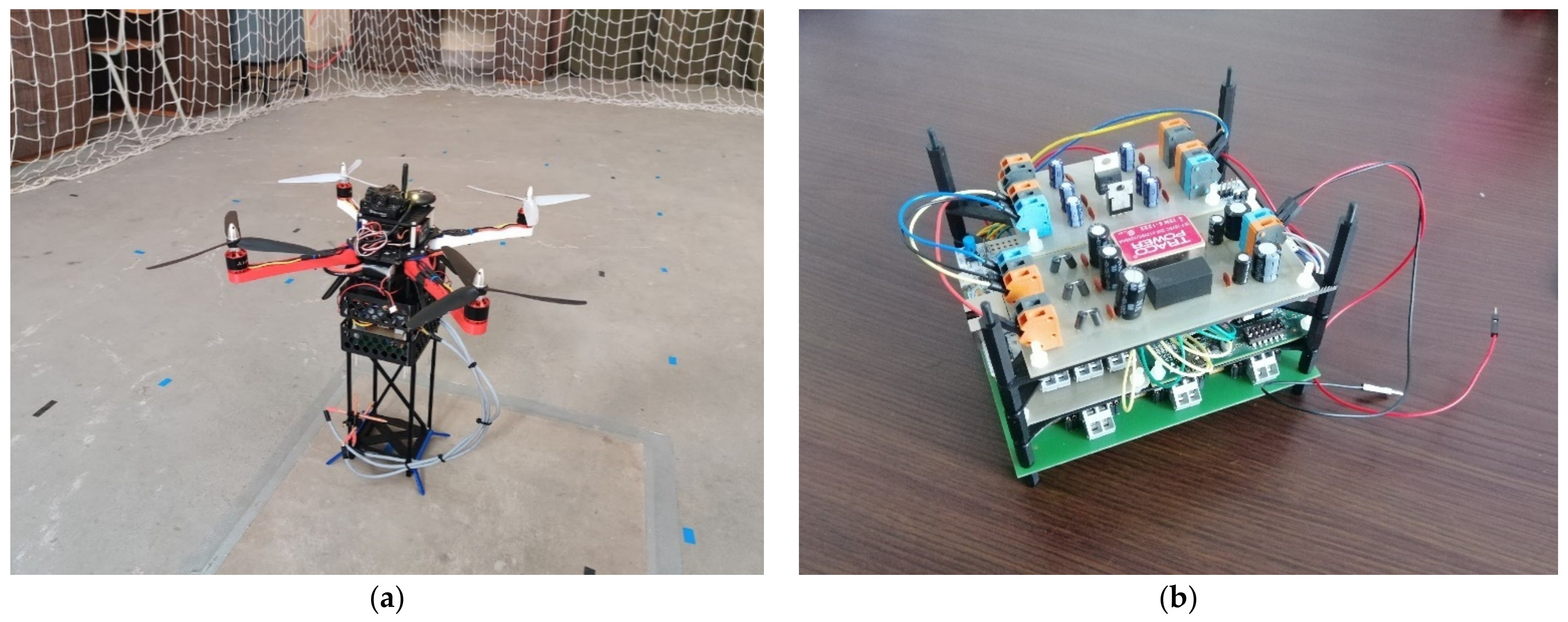

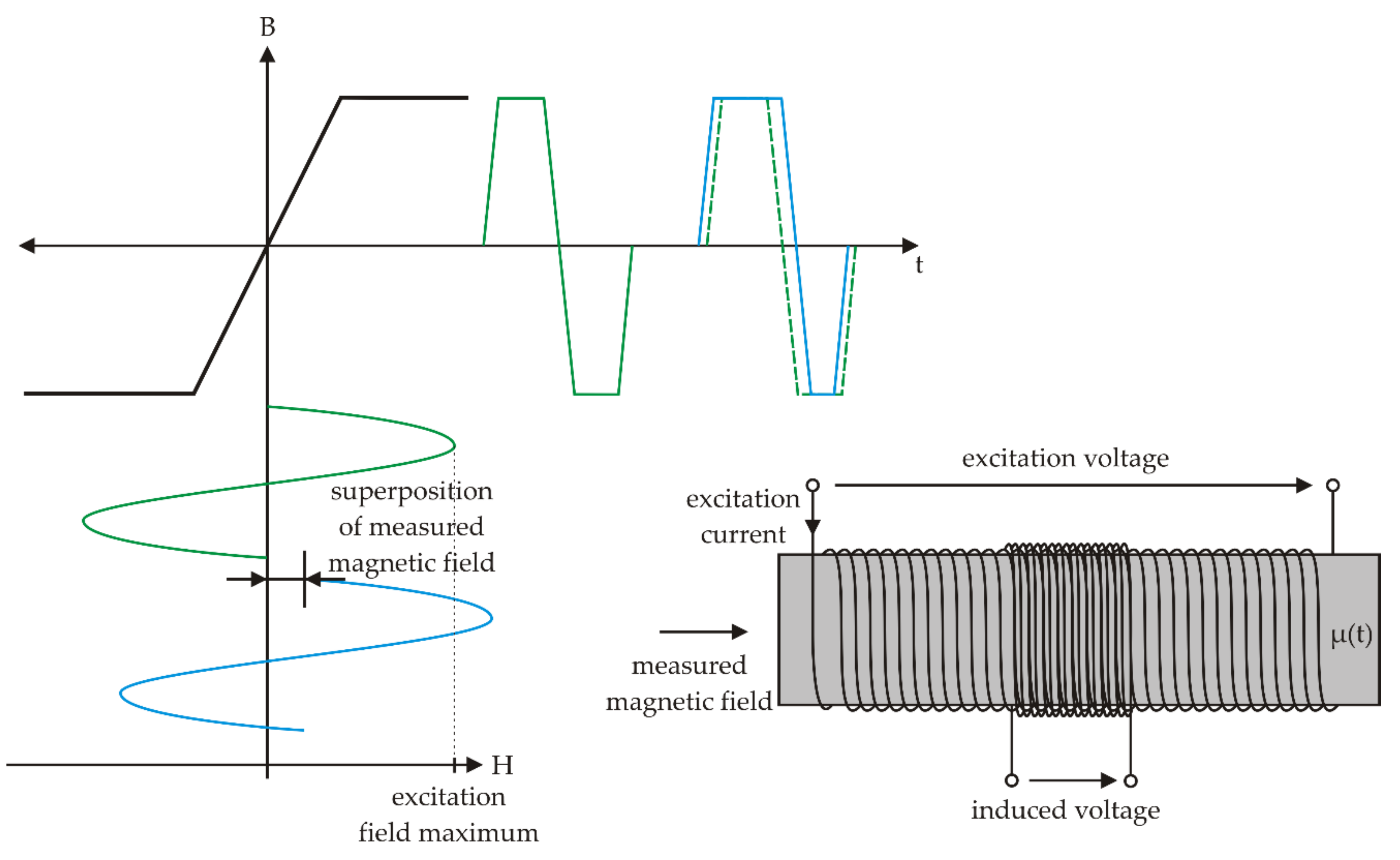

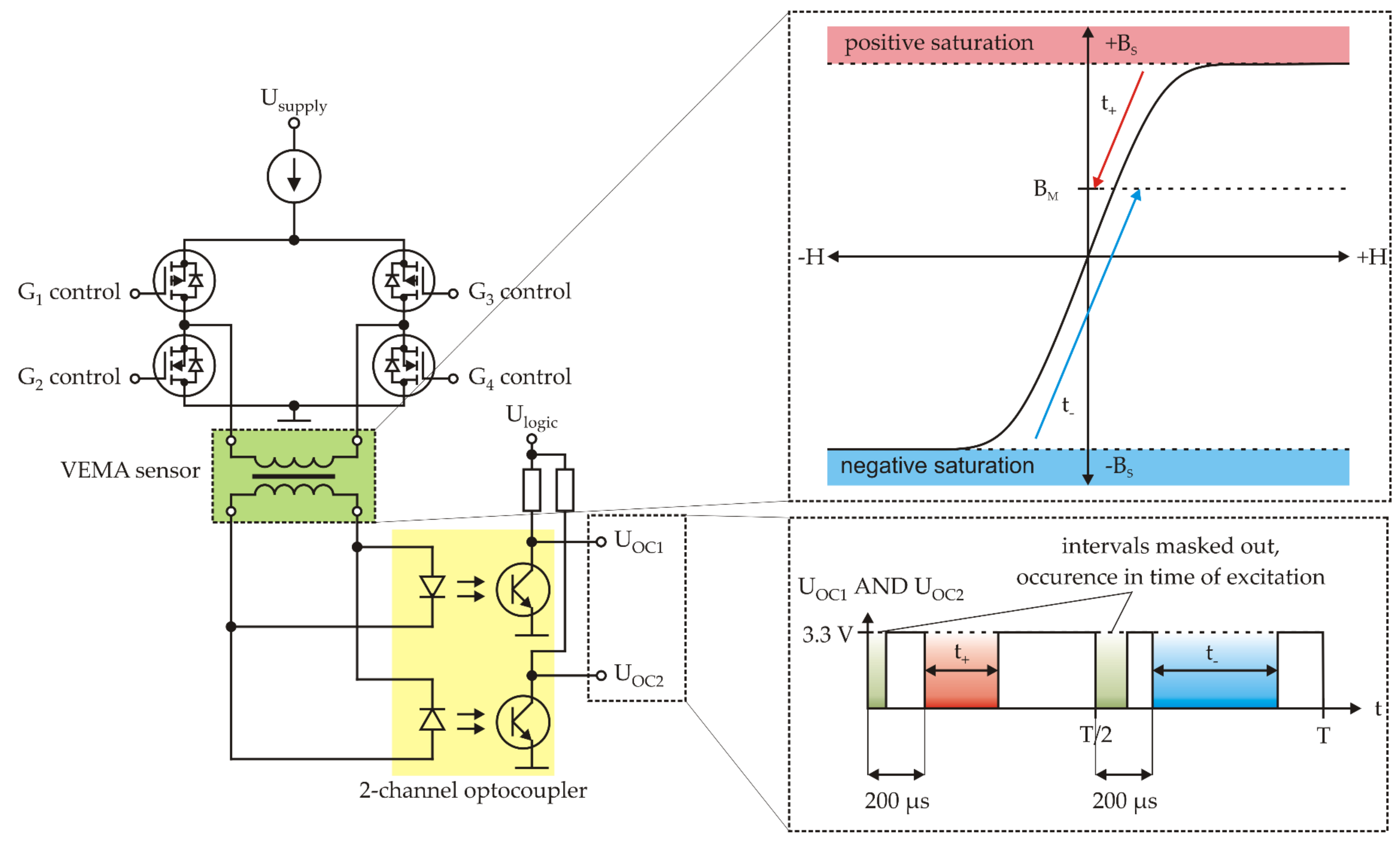


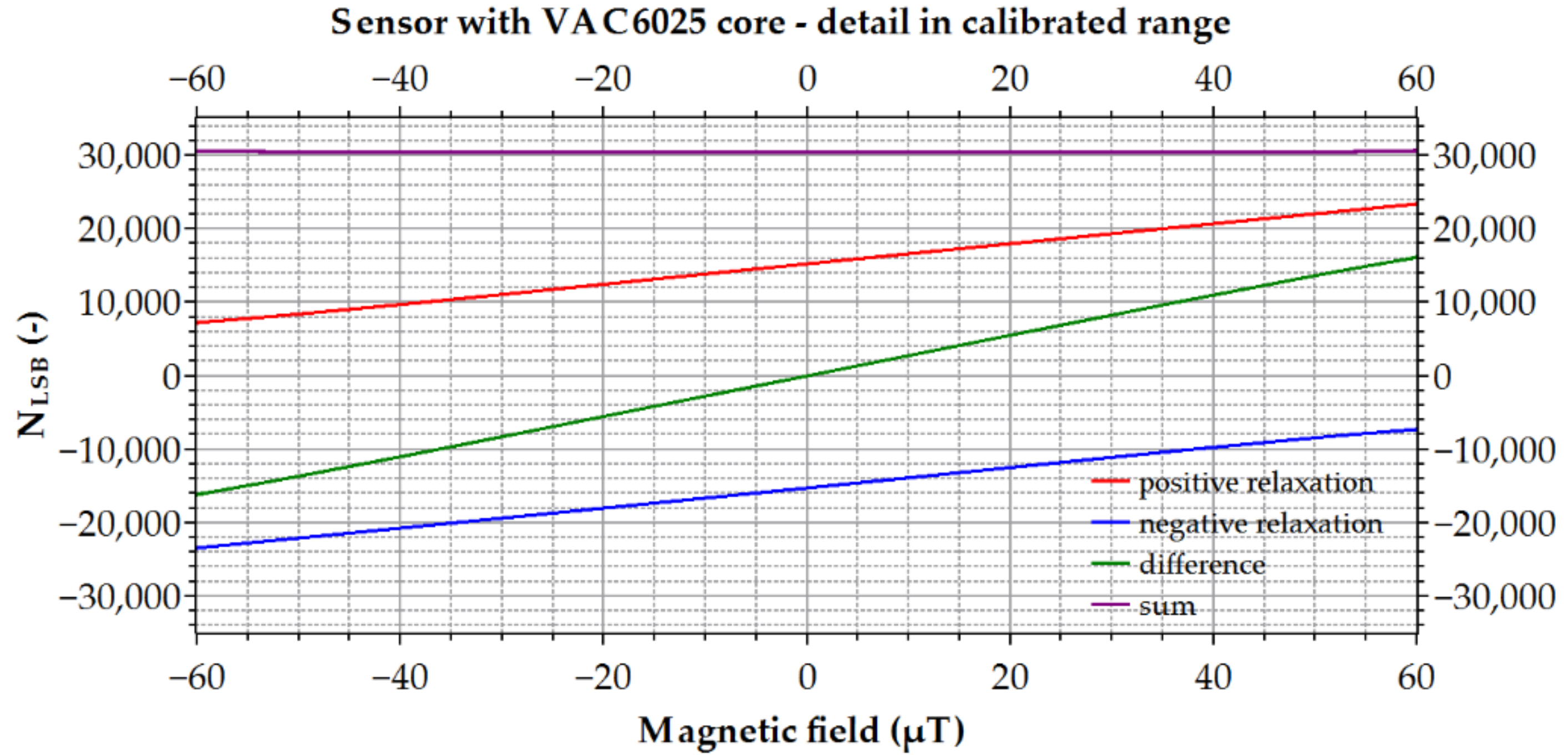
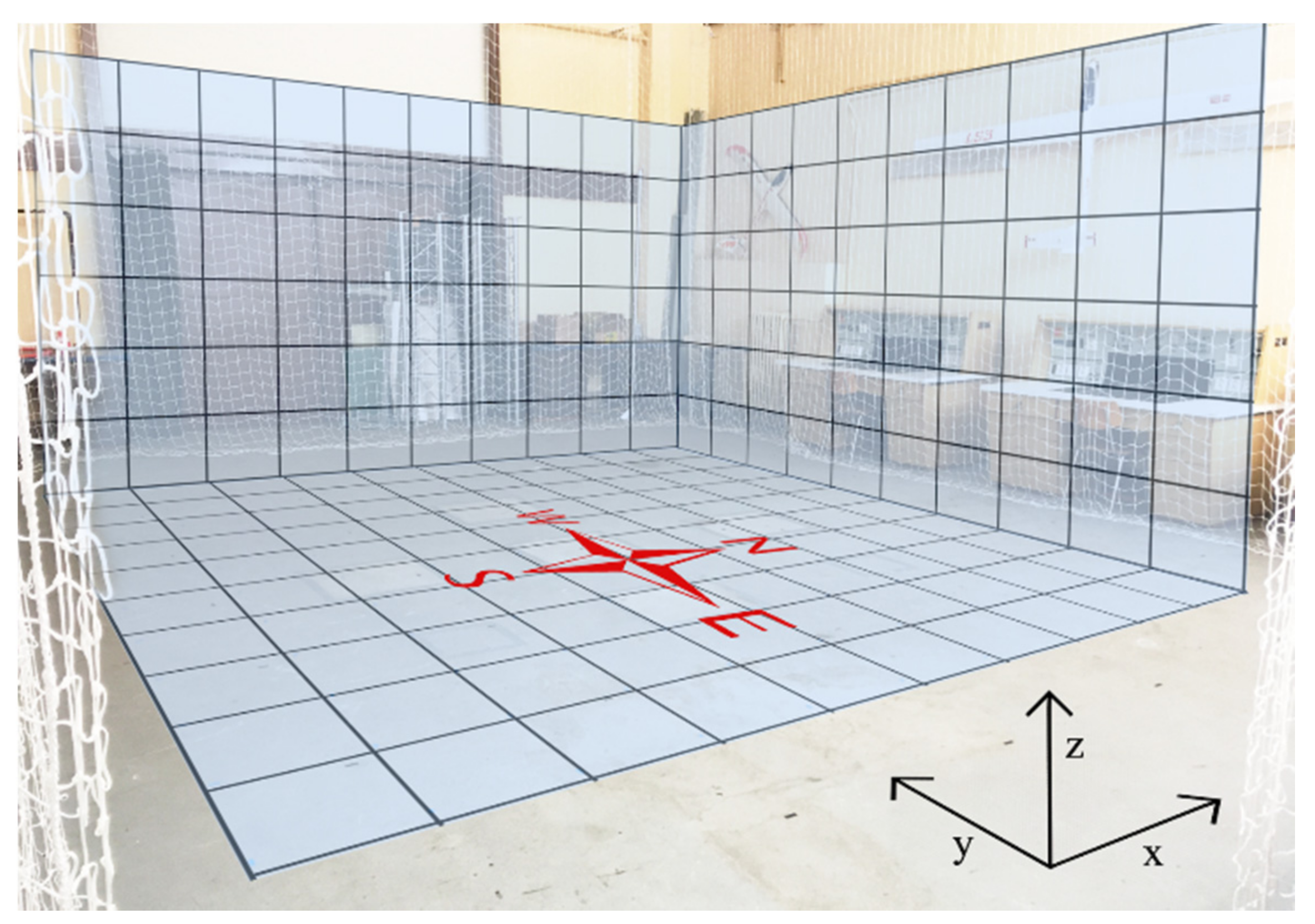

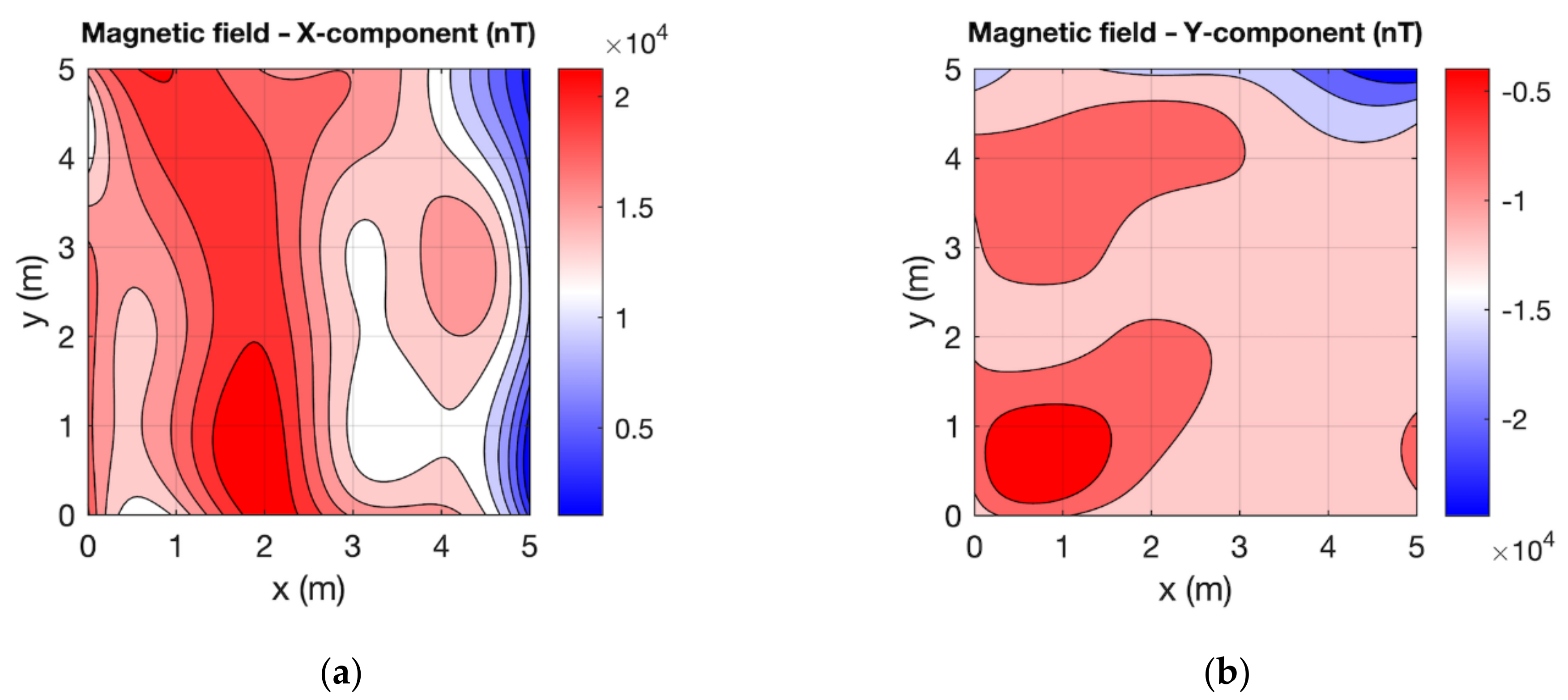
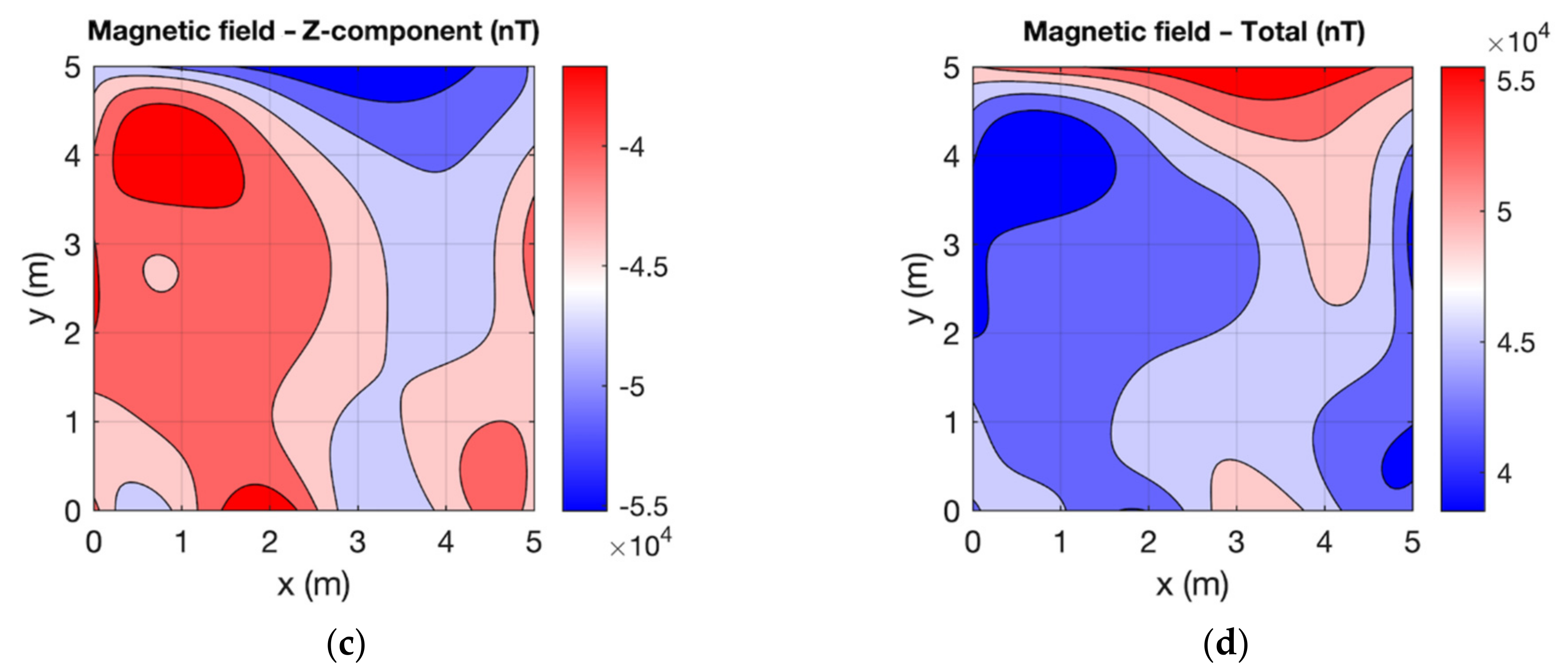




| Frequency Range | E-Field Strength E (kV·m−1) | Magnetic Field Strength H (A·m−1) | Magnetic Flux Density B (T) |
|---|---|---|---|
| 1 Hz–8 Hz | 20 | 1.63 × 105/f2 | 0.2/f2 |
| 8 Hz–25 Hz | 20 | 2 × 104/f | 2.5 × 10−2/f |
| 25 Hz–300 Hz | 5 × 102/f | 8 × 102 | 1 × 10−3 |
| 300 Hz–3 kHz | 5 × 102/f | 2.4 × 105/f | 0.3/f |
| 3 kHz–10 MHz | 1.7 × 10−1 | 80 | 1 × 10−4 |
| Frequency Range | E-Field Strength E (kV·m−1) | Magnetic Field Strength H (A·m−1) | Magnetic Flux Density B (T) |
|---|---|---|---|
| 1 Hz–8 Hz | 5 | 3.2 × 104/f2 | 4 × 10−2/f2 |
| 8 Hz–25 Hz | 5 | 4 × 103/f | 5 × 10−3/f |
| 25 Hz–50 Hz | 5 | 1.6 × 102 | 2 × 10−4 |
| 50 Hz–400 Hz | 2.5 × 102/f | 1.6 × 102 | 2 × 10−4 |
| 400 Hz–3 kHz | 2.5 × 102/f | 6.4 × 104/f | 8 × 10−2/f |
| 3 kHz–10 MHz | 8.3 × 10−2 | 21 | 2.7 × 10−5 |
| ELF Magnetic Field | Daytime Exposure | Nighttime Exposure | Sensitive Populations |
|---|---|---|---|
| Arithmetic | 100 nT | 100 nT | 30 nT |
| mean (AVG) | (1 mG) | (1 mG) | (0.3 mG) |
| Maximum | 1000 nT | 1000 nT | 300 nT |
| (MAX) | (10 mG) | (10 mG) | (3 mG) |
Publisher’s Note: MDPI stays neutral with regard to jurisdictional claims in published maps and institutional affiliations. |
© 2021 by the authors. Licensee MDPI, Basel, Switzerland. This article is an open access article distributed under the terms and conditions of the Creative Commons Attribution (CC BY) license (https://creativecommons.org/licenses/by/4.0/).
Share and Cite
Lipovský, P.; Draganová, K.; Novotňák, J.; Szőke, Z.; Fiľko, M. Indoor Mapping of Magnetic Fields Using UAV Equipped with Fluxgate Magnetometer. Sensors 2021, 21, 4191. https://doi.org/10.3390/s21124191
Lipovský P, Draganová K, Novotňák J, Szőke Z, Fiľko M. Indoor Mapping of Magnetic Fields Using UAV Equipped with Fluxgate Magnetometer. Sensors. 2021; 21(12):4191. https://doi.org/10.3390/s21124191
Chicago/Turabian StyleLipovský, Pavol, Katarína Draganová, Jozef Novotňák, Zoltán Szőke, and Martin Fiľko. 2021. "Indoor Mapping of Magnetic Fields Using UAV Equipped with Fluxgate Magnetometer" Sensors 21, no. 12: 4191. https://doi.org/10.3390/s21124191
APA StyleLipovský, P., Draganová, K., Novotňák, J., Szőke, Z., & Fiľko, M. (2021). Indoor Mapping of Magnetic Fields Using UAV Equipped with Fluxgate Magnetometer. Sensors, 21(12), 4191. https://doi.org/10.3390/s21124191






